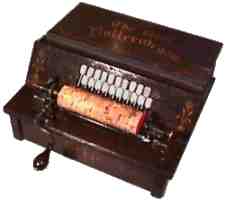

|
In the late 1880's, the Autophone Company of Ithaca, New York, began producing a line of hand-cranked roller reed organs. The early models were operated by pressure, with exposed bellows. When the company began producing vacuum-operated models, some were called simply "The Roller Organ" or "The American Music Box". But the most common and least expensive was called "The Gem Roller Organ". It was by far the most popular, at possible production levels of tens of thousands in a single year. Its black stenciled case and open roller frame allowed a retail price as low as $3.25 with 3 rollers. Sales volume was made possible by contracting with such distributors as Sears Roebuck and Company, who featured a model showing their own stencil in their catalogs. The Gem was also sold as "The New American Music Box" as well as several private labels. A few variations appeared with such enhancements as walnut finishes, or hinged front swell covers as on the "Home Music Box". The 20-note Rollers, mass produced and pinned by machine and priced as low as 18 cents each, "cost less than [...] ordinary sheet music", and so hundreds of thousands were sold, of over 1200 titles. (See also the Roller List). A "step up" in the product line, the "Concert Roller Organ", also sold as the "Chautauqua Roller Organ", used the same 20-note Rollers as the Gem. But these were available in larger and more ornate walnut or oak cases, with a glass front swell cover, and sold for as little as $7.60. Improved exhausters provided smoother cranking, and the extensive list of Rollers aided sales. The "Grand Roller Organ" was the top of the line, using the larger 32-note Rollers. The case was usually oak, rather than walnut. A higher price of $14.95 or more for the Grand with three Rollers, and 65 cents or more for additional rollers prevented large sales quantities. Likewise, fewer titles of 32-note Rollers were manufactured. (See also the Roller List). Since the manufacturing date was usually printed on the bottom of the case, it is relatively easy to date particular instruments. Rollers are copyrighted July 14, 1885, and Gems appear from the late 1880's through the late 1920's--an amazing lifespan for a single basic design. Their success may be attributed to the full, rich sound and pleasing music arrangements, with the low cost for a basic model. And today, those same features contribute to their collectability. |